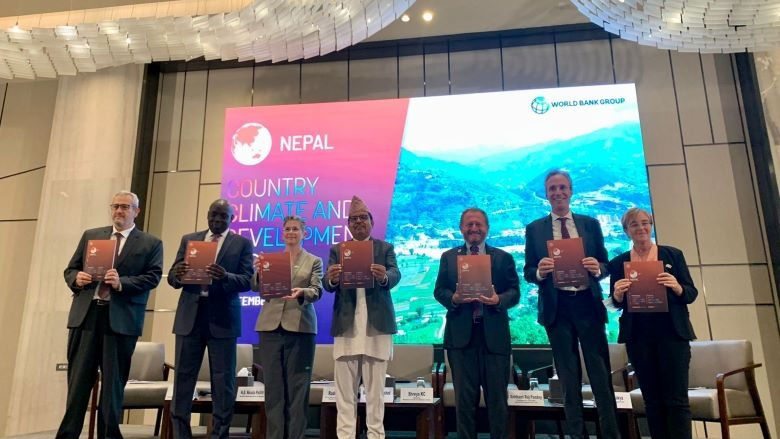AT A GLANCE
Nepal’s poverty reduction story over the last 30 years is nothing short of remarkable; its US$2.15 poverty rate fell from over 55 percent in 1995 to 0.37 percent in 2022, a feat as impressive as almost any country in history. Yet, it has done so without transformative domestic growth, investment, or job creation. Nepal’s greatest challenge now is to realize its full potential by building an economy that creates sustained domestic growth and jobs.
Nepal’s reliance on remittances – which has been such an important element in the country’s poverty reduction story – has been central to the country’s growth but has not translated into quality jobs at home, reinforcing a cycle of lost opportunities and the continued departure of many Nepalis abroad in search of employment. A staggering 82 percent of Nepal’s workforce is in informal employment, far higher than global and regional averages.
Nepal is also highly exposed to natural disasters and climate shocks – it is the second most vulnerable country globally to mortality risk from multiple hazards, including earthquakes, natural disasters (including those exacerbated by a changing climate), and disease outbreaks. Growth and development in Nepal cannot happen without sustained efforts to reduce risks, prepare for crises, and build resilience across the economy to these threats.
COUNTRY CONTEXT
Ten years after a Comprehensive Peace Agreement ended the conflict in Nepal, the 2015 Constitution restructured the country from a unitary state under a monarchy into a federal democratic republic. The 2015 Constitution introduced a three-tiered system of public administration comprising a federal government, seven provincial governments, and 753 local governments. Nepal’s political system is characterized by a multi-party democracy and, since the onset of democracy, governments have been coalition-based.
The rollout of the federal public administration structures has begun in earnest, but serious implementation challenges persist. Since the adoption of the 2015 Constitution and the country’s transition to federalism, some progress has been made in establishing institutional structures, adopting key legislation, and building the core blocks of public financial management. At the same time, building a fully functioning federal system has been slow, with key legislative reforms still pending and roles and responsibilities often not fully defined. Challenges persist in establishing a fiscal system that fully aligns with the needs of the new federal structure. Additionally, broader political challenges hinder the administrative and policy decisions required to help the system reach its full potential.
KEY CONDITIONS AND CHALLENGES
Nepal experienced its worst unrest in decades on September 8–9, 2025. A social media ban triggered protests against corruption, and this was followed by widespread unrest causing significant human and economic losses. The damage to public and private infrastructure is still being assessed. On September 9, Nepal’s Prime Minister resigned, and an interim administration was appointed on September 12 to oversee the lower house parliamentary election scheduled for March 5, 2026.
The protests highlighted frustration with governance and the lack of economic opportunities for Nepal’s youth. Nepal’s economic growth has lagged peers, averaging 4.3 percent annually from fiscal year 2012 (FY12) to FY24, weighed down by structural weaknesses in the private sector, including a complex business environment, corruption, high trade and transport costs, and inadequate infrastructure. Sluggish growth has limited job creation with youth unemployment reaching 22.7 percent in FY23, among the highest in South Asia. As a result, labor migration has become a primary livelihood strategy, and remittances—averaging nearly 23 percent of GDP over FY12–24—have been crucial for sustaining basic consumption. Without these remittances, an estimated 2.6 million more people would have been in poverty.
Implementing the reforms proposed by the High-Level Economic Reform Commission in April 2025 will be critical to address these structural challenges. Key priorities include simplifying tax policy and administration, creating policy certainty and increasing transparency, tackling corruption and cutting red tape, making service delivery more efficient and responsive to citizen’s needs, and accelerating the implementation of public capital investments (critical reforms to achieve this are highlighted in the special focus of this development update). Effective implementation of these reforms could help strengthen governance, boost growth and shared prosperity, and create more jobs.
RECENT ECONOMIC DEVELOPMENTS
Nepal's economic growth picked up to 4.6 percent in the FY25 from 3.7 percent in FY24. The rebound was led by manufacturing and construction, supported by increased hydropower generation. Agriculture also contributed positively with paddy output rising despite flood damage. The services sector performance was mixed. Growth slowed in tourism, affected by Tribhuvan International airport (TIA) upgradation works and geopolitical tensions that disrupted international flights to Nepal via the Middle East. Financial sector activities were impacted by subdued credit demand and rising non-performing loans (NPLs). On the other hand, wholesale and retail trade performed well supported by higher merchandise imports and improved access to trade finance.
Headline inflation declined to 4.1 percent in FY25 from 5.4 percent in FY24 falling below the Nepal Rastra Bank’s (NRB) 5 percent ceiling. Both food and non-food inflation moderated although this was partly offset by rising transport costs due to higher public transport fares.
The monetary policy stance remained cautiously accommodative, underpinned by comfortable foreign exchange reserves and easing inflation. The policy rate was reduced by 50 basis points to 5.0 percent at the start of FY25 following a sharper 150-basis-point cut in FY24. As monetary easing continued, lending rates fell more sharply than deposit rates, reaching a record low of 8.7 percent. Nevertheless, private sector credit expanded only modestly, as weak demand and rising NPLs constrained lending. The NPLs ratio climbed to 4.6 percent at the end of FY25 from 3.9 percent at the end of FY24. This increase occurred despite the introduction of forbearance measures for the construction sector and for small loans (up to NPR 50 million) in select sectors such as agriculture and fishing that had accounted for a large share of NPLs in FY24. However, banks maintained strong capitalization, and overall profitability improved marginally.
The current account surplus widened further in FY25 rising to 6.7 percent of GDP from 3.9 percent of GDP in FY24, supported by remittances. Healthy remittances were driven by Nepali workers moving to new, higher-wage destinations such as Japan and South Korea, a weaker Nepali Rupee, and increased use of formal transfer channels. The trade deficit remained stable in FY25 as both exports and imports picked up sharply. Export growth was driven by refined edible oils - mainly soybean and sunflower oil re-exported to India - after India raised import tariffs on edible oils from non-SAFTA countries. Imports increased in parallel, reflecting higher crude edible oil purchases from major suppliers, including Argentina and Brazil. The widening current account surplus contributed to robust foreign exchange reserves, which picked up to cover 15.4 months of import by end of FY25.
The fiscal deficit narrowed to a nine-year low of 2 percent of GDP in FY25 supported by stronger revenue mobilization. Revenues (including grants) picked up to 20 percent of GDP in FY25 from 19.4 percent of GDP in FY24, bolstered by higher VAT collections, increased excise duties on alcohol and beer, and increased trade-based revenues from rising merchandise imports and higher customs duty rates. Total expenditure increased slightly from 21.9 percent of GDP in FY24 to 22 percent in FY25 driven by larger budget allocations for capital spending rather than improved execution. Capital expenditure execution remained weak at 63.2 percent in FY25 (slightly lower than the 63.5 percent in FY24) held down by several challenges across the project cycle as discussed in detail in the special focus chapter. Recurrent spending declined marginally from 18.5 percent of GDP in FY24 to 18.3 percent of GDP in FY25, reflecting lower domestic interest payments and reduced fiscal transfers to subnational governments.
ECONOMIC OUTLOOK
Reflecting the recent unrest and heightened political and economic uncertainty, real GDP growth is projected to slow to 2.1 percent in FY26 in the baseline scenario, with a potential range of 1.5 to 2.6 percent. Consequently, poverty rates (at USD 4.2/day) are slightly higher than previously projected, reaching 6.6 percent in FY26 and 5.9 percent in FY27 compared with 6.2 percent and 5.4 percent projected before the unrest. Reconstruction efforts are expected to begin in FY26 and gain momentum in FY27, supporting a recovery in GDP growth to 4.7 percent in FY27.
The projected growth slowdown in the baseline is expected to be largely driven by the services sector. Tourism activity is projected to decline sharply, reflecting a significant decline in international tourist arrivals, while the spillover effects of asset losses are expected to weigh on insurance services. The services sector is projected to recover in FY27 as tourism rebounds, insurance shocks dissipate, and government measures, such as insuring public property, support demand. Industrial sector growth is projected to slow marginally in FY26 compared to FY25. Hydropower-related industrial activity is expected to remain robust, but non-hydropower-related private investment and construction is projected to be weighed down by weaker investor confidence following the unrest. Industrial sector growth is expected to pick up sharply in FY27, supported by public projects and reconstruction efforts. Agriculture growth is projected to soften in FY26 due to delayed paddy planting, particularly in Madhesh Province, but is expected to recover in FY27 assuming favorable monsoon conditions.
Inflation is expected to remain within the central bank’s 5 percent ceiling over the medium term. Easing global commodity prices, moderating inflation in India (transmitted through the currency peg), and softer cost pressures will help contain prices. However, these gains would be partially offset by a potential decline in domestic paddy output, which could keep food inflation elevated in FY26.
The current account surplus is projected to widen in FY26, driven by rising remittances despite a projected increase in the trade deficit and underperformance in tourism. The trade deficit is expected to widen slightly in FY26, led by imports of merchandise—particularly crude edible oils and construction equipment for hydropower— and more substantially in FY27 with higher demand linked to non-hydro construction projects. Tourism receipts are expected to decline. These downward pressures on the external account are expected to be offset by robust remittance growth, resulting in a widening of the current account surplus from 6.7 percent of GDP in FY25 to 7.3 percent in FY26. The surplus is projected to moderate in FY27 as remittances level off. FDI inflows are likely to remain subdued over the medium-term. Foreign exchange reserves are expected to stay comfortably above the regulatory minimum of seven months of import cover.
The fiscal deficit is projected to widen in FY26 to 2.8 percent of GDP driven by increased spending on reconstruction, elections, private sector relief, and outstanding liabilities. These increased spending needs are expected to be partially offset by announced austerity measures and reprioritization of development projects, supported by relaxed virement rules. Nominal revenue growth is projected to slow in FY26, reflecting weaker import growth and lower VAT and corporate income collections, particularly from the insurance and tourism sectors. The deficit is forecast to narrow in FY27 as revenues recover. Deficits are expected to be financed through a mix of external concessional and domestic borrowing within statutory ceilings. Public debt is projected to increase from 43.6 percent of GDP in FY25 to 45.2 percent in FY26 and stabilize thereafter keeping Nepal at low risk of debt distress.
The outlook is subject to mixed risks. Key downside risks include rising frequency of natural disasters and persistent political uncertainty weighing on economic activity, higher NPLs straining the domestic financial sector, Nepal’s continued presence on the Financial Action Task Force Grey List, and disruptions to public services and core administrative processes reflecting damage to public infrastructure. On the upside, a successful political transition and sustained macroeconomic management could strengthen investor sentiment supporting a stronger economic recovery.
Last Updated: Nov 13, 2025




